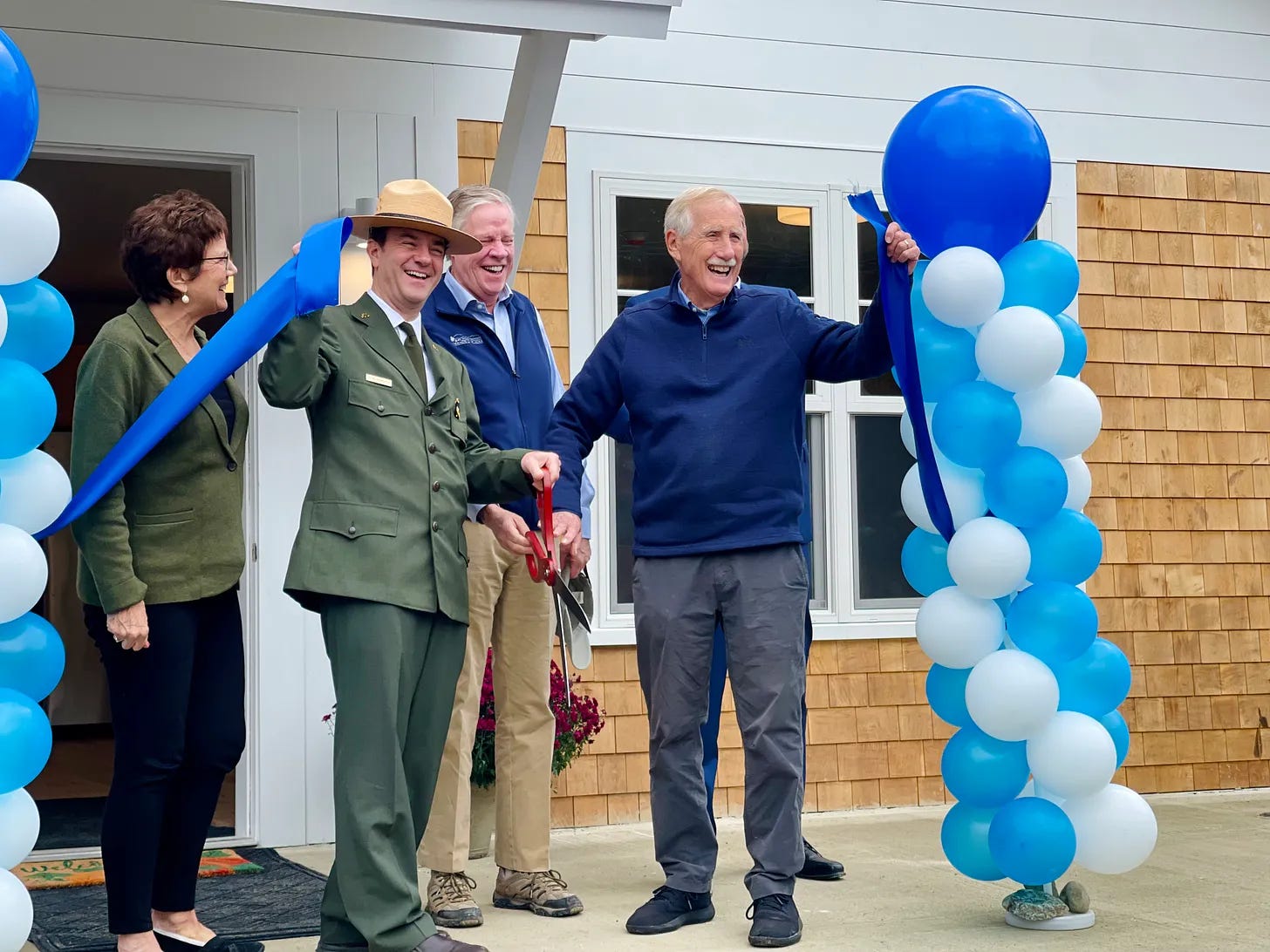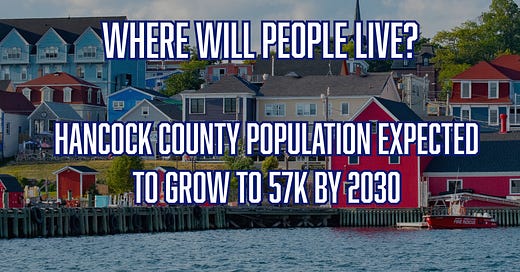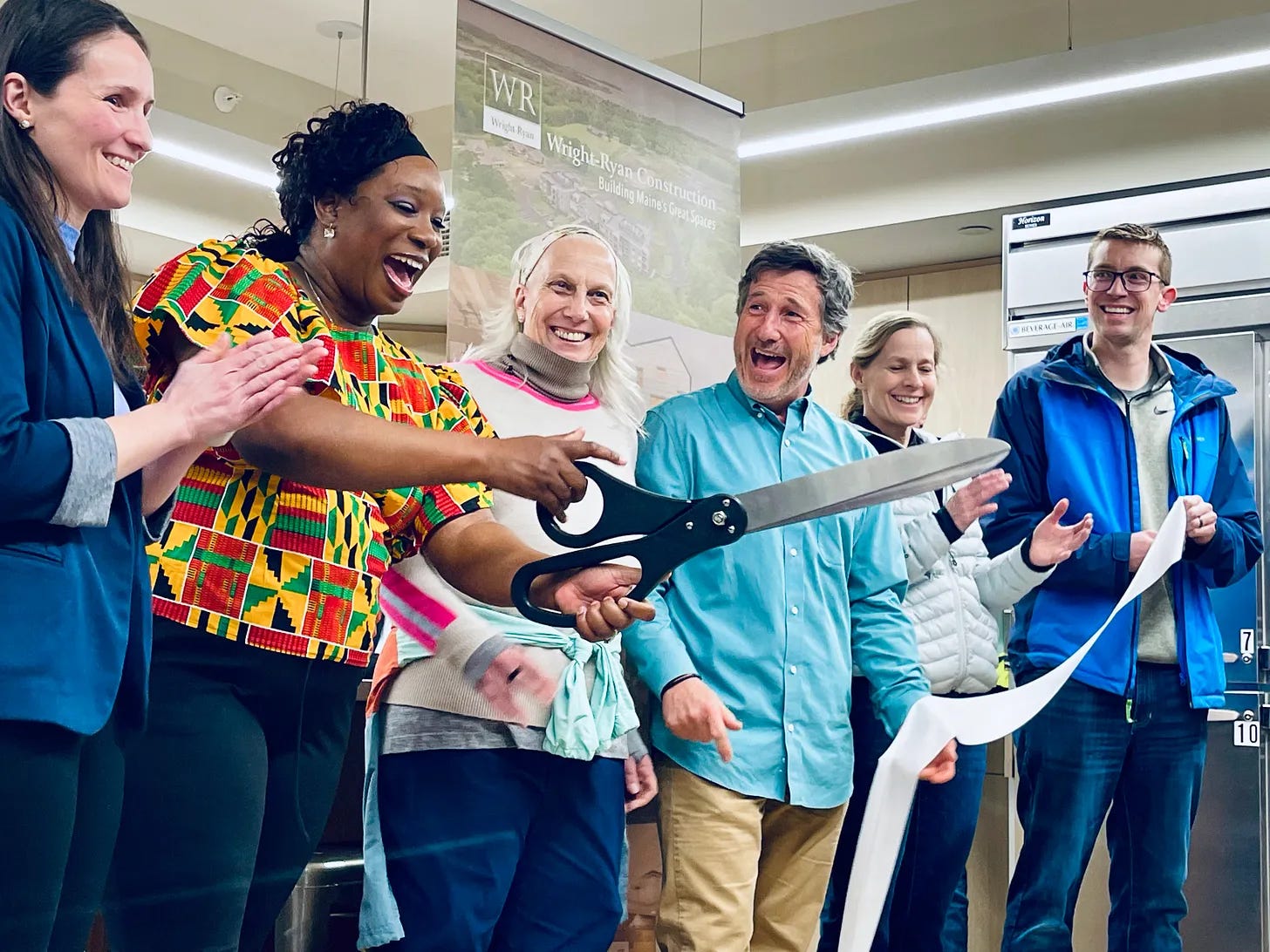The Bar Harbor Story is generously sponsored by First National Bank.
ELLSWORTH—Where will people live?
That’s the complicated question that planners, employers, administrators and people looking for homes are struggling with throughout Maine.
With Hancock County’s population expected to grow to almost 57,000 by 2030, while the average household size decreases, the towns and people within them face some major obstacles when it comes to affordability, availability, and location of homes, a recent report from the Hancock County Planning Commission reads. The current population’s last estimate from 2020 is 55,478.
The problem is that the housing stock itself—where people live—is not currently predicted to change. Almost one-third of homes in the area are vacant for “seasonal, recreational, or occasional use,” the report says.
Approximately 11% of the units that had been homes, according to the report, are now listed as active short-term rentals. Most of those rentals were single-family units.
“Wages in some of the most prominent industries do not meet the amounts currently needed to live comfortably, and median household incomes are not keeping pace with the rise of the median home price,” the report writes. “Short-term rentals and seasonal housing, while beneficial for those that own them, limit the supply of housing for year-round residents, more so in some areas than others. Aging residents, combined with lower incomes, limited rental availability, and a lack of nursing homes for these individuals presents challenges for adequately housing this population moving forward. Additionally, the natural landscape and rural nature of the county limits where development can take place, and often times making development feasible is associated with high costs to access or expand infrastructure and utilities.”
It’s an issue that towns and citizens have been discussing in board rooms, council chambers, at housing summits, and over meals.
The Hancock County Planning Commission (HCPC) released the 292-page county-wide housing assessment in January. Filled with data and graphs, it looks—daunting.
“Housing is a big deal,” Noel Musson told those attending a League of Towns meeting in Ellsworth in January.
In 2012 Musson started the Musson Group, which is on the frontlines of Mount Desert Island’s hopes to increase homes. It organized multiple housing summits looking at the issue.
From its website, the Musson Group states that it is “a planning consultancy specializing in land use and community planning, economic development, geographic information services (GIS), permitting, and project management. Founded in 2012, The Musson Group is a leader in project management, planning, and permitting in the state of Maine.”
The HCPC’s assessment is meant to evaluate the county’s housing needs as well as be a reference guide to help make housing decisions.
“This assessment should also serve as a resource for municipal officials, planners, employers, developers, financers, and other housing stakeholders when searching and applying for funding opportunities that can support the creation and preservation of housing,” it writes.
How to create more homes for people in the area is also something that organizations like Musson’s, the Island Housing Trust, the YWCA MDI, Friends of Acadia, Acadia National Park, individual businesses, and towns have been working on piece by piece.
Extending the sewer in Mount Desert is before the voters at town meeting and if it is approved, it will allow more homes to be easily developed past Farnham Way.
Bar Harbor donated building fees paid for by the YWCA of Mount Desert Island back to it for an affordable housing project in Bar Harbor at Hamilton Farm. It’s also involved with a potential project for housing with Acadia National Park and has created uses within the town’s zoning laws to allow for different employee housing types in some zones as well as shared accommodations. It’s also hired Cali Martinez, a community and housing planner.

Friends of Acadia has worked with Acadia National Park to try to find and build housing for seasonal workers and also for bus drivers. According to its website, “Dane Farm in Seal Harbor is already under construction and will house eight seasonal workers by spring 2025. Harden Farm, which is in the design and planning phase currently, will provide 56 beds when completed. These two campuses will provide the park with essential workforce housing for decades.”
The opening of the first large, shared accommodation buildings in downtown Bar Harbor last March, a project by Witham Family Hotels, is meant to house more than 80 employees.

Jermel McWhorter and his family moved into a long-term rental home offered to him with Witham Family Hotels this winter. This home was previously occupied by seasonal employees but is well suited for a family to live in year-round.
"Living in Bar Harbor just minutes away from work is a dream come true. I joined The Bar Harbor Inn in 2019 and have been commuting since then, falling in love with the staff and property,” McWhorter said. “Commuting from Carmel takes roughly an hour and a half each way due to road conditions, limiting time with my family. My wife understands my dedication to work, never making it an issue, and I cherish the days off spent with my family. Being closer now allows me more quality time with my wife and three children, which is invaluable. Previously, work schedules and their sleep schedule kept me away from seeing my kids for days, but now I have extra time in the morning and evening with them. This time is crucial for their development, and I am grateful for the opportunity to be closer to my family on this beautiful island."
Shared septic systems and other tools happen on individual town levels. A simple review of town rules and ordinance standards in each town can potentially help promote development of housing, Musson said.
LEAGUE OF TOWN’S ROLE
Despite a limited amount of hours in the day and a limited budget, the League of Towns (LOT)—a group of administrators from multiple towns in the Mount Desert Island region, plus Trenton, Lamoine, and Ellsworth meet almost every month.
Discussion is almost always friendly and, despite the official agenda, the members of the LOT are informal as they gather in a rotating assortment of town hall spaces. All the meetings are open to the public, but the public seldom attends.
Last fall, the LOT hosted an elected officials meeting to discuss how the towns could work together on what is perceived by many in local government as the biggest issues: housing and transportation.
The Musson Group moderated the event, which was at the Neighborhood House in Northeast Harbor.
“One of the hopeful long-term benefits and results is supporting this collaboration,” said Susanne Paul, senior planner & GIS analyst for the Musson Group.
Another meeting of the elected officials of the towns involved in the League of Towns is set for April 17. That meeting will continue on its work from the fall.
The last group meeting at the Neighborhood House cost approximately $1,600. Town Manager Durlin Lunt and LOT president proposed using the same venue on April 17, the third Thursday, again at the Neighborhood House in Mount Desert.
“It would basically be a follow-up?” Lamoine Administrative Assistant to the Select Board Stu Marckoon asked.
“I thought that meeting was useful and I think we need to follow up,” Lunt said, and then at that meeting create an action plan.
The LOT increased its budget by $1,000 to cover the cost of the follow-up meeting. That cost will be split amongst the towns.
“There is value in thinking and planning and analyzing at this geography—at the League of Town scale,” Paul said.
They hope to draft key takeaways or data points at the LOT scale. Those takeaways will help create goals and action plans for the micro-region.
Nancy Smith, the CEO of GrowSmart Maine (a advocacy organization), lives in Ellsworth. Two years ago she told the Bar Harbor Story that there are multiple pressures on housing. People migrating into the state and investor-owned short-term rentals, aging housing stock, Maine’s status as a vacation destination and its number of second homes all combine to elevate prices and decrease stock.
Similarly, interest rates on loans and mortgages are currently high, building materials are high, and labor costs are high. Regional solutions, she stressed, are the best approach, especially when it comes to short-term rentals.
Compounding the problem is that when housing is built outside of a town’s main compact, it brings costly infrastructure needs for sewer and water lines, or it can increase demands on aquifers.
“Lack of housing choices has been perceived as a problem facing only some parts of Maine…until the past few years. Now, even our most rural communities are seeing interest from people who are choosing to live here, either because of all the quality of life attributes Maine has to offer, or more specifically, because of long term concerns of climate change and the chance to rethink where they chose to live after enduring pandemic lockdowns,” she’d said.
Sharing collective tools is important as well, the LOT also decided.
“You can’t necessarily do the whole thing in one fell swoop,” Lunt said about LUO and LUZO changes in towns.
“We need to think of our ordinances—particularly housing—that their in locations and densities that are particular to that area,” Musson said.
“Some of the things most cherished about a community,” Lunt said can’t occur once restrictive zoning comes in.
It’s about a balance, they agreed.
UPCOMING MEETINGS FOR THE LOT:
February 2025- Trenton Town Office
March 2025- Acadia National Park Headquarters
May 27, 2025- Southwest Harbor Town Office
June 24, 2025- Lamoine Town Office
July - Tremont Town Office
LINKS TO LEARN MORE
You can learn more about MaineGrow’s public policy link on its website: https://growsmartmaine.org/public-policy/
It takes a region to deal with housing
This will be the first in a series of stories about the report and its data. To find all the articles in the series, go to the Bar Harbor Story website and in the search bar, look for “housing.”
If you’d like to donate to help support us, you can, but no pressure! Just click here (about how you can give) or here (a direct link), which is the same as the button below.
If you’d like to sponsor the Bar Harbor Story, you can! Learn more here.














I learned so much from your detailed reporting. Amazing work. Thank you…I’d never know these details without your work.